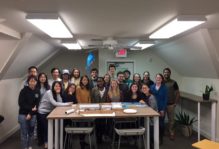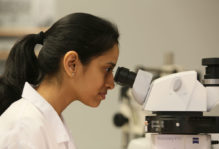Geology Rocks…Seriously
I spent this summer in Moab, Utah, working on my senior thesis in Geology. When I wasn’t taking breaks from the heat with my three research partners (Lauren Lamp and Matt Sparacino from William & Mary, and Tevis Blom from Colorado University), I was studying bedrock channels—rivers that run over rock—and how the weathering of rock causes them to evolve. This is a surprisingly complex question, but it’s one that needs an answer. Bedrock channels are critical in shaping some of the most impressive landscapes on the face of the earth. The Grand Canyon, the Rocky Mountains, and the Badlands all owe much of their carving to channels that develop over their hard rock surfaces—something that we don’t see that often in Williamsburg. Among many other reasons why we study bedrock channels, the landscape change that takes place as they evolve can significantly impact human structures. If you built a house, bridge, or skyscraper right on the edge of an active bedrock channel valley, it is more than likely that you would find its remnants in the river that is carving it within a few hundred years. Clearly, knowing how the geometry of bedrock channels changes is very important to people all over the world.
Getting to perform field work for the first time was fantastic. However, the most amazing thing about my summer was the location. I had never been to the “Wild Wild West” before, and Will Smith’s song hadn’t come close to doing it justice. I would look up from the rocks that I was working on and see sandstone cliffs rising 200 feet above me. The cliffs, canyons and topography of Moab were not merely visually inspiring; they also made me think about how much time that it took for such natural beauty to be carved. Considering how landscapes form and how long it takes them to do so is, for me, the coolest part of what I study.
But the coolest part of the trip—literally—was what we got to do when we needed a break. Tevis, the CU grad student, designated the phrase “I don’t know” as a sacred safe-word. If any of us responded to a question about numbers, calculations, or field notes with those three words, it meant that the desert sun was too hot to handle, and that we all needed to take a break. We took this rule very seriously, so it happened rarely (I have to say that: my research advisor might be reading). But when we did get the chance to escape our beautiful but oven-like study sites of 100-odd degrees, we would get in “the Juggernaut”—the research vehicle that we clearly became emotionally attached to—and drove until we found ourselves in the La Sal mountain range, merely 20 miles away. There, both the view and the temperature were unbelievable: not only could we see all of Moab from the heights of the La Sals, but we could view them at a comfortable 60 degrees Fahrenheit. While I learned in Geo 101 that the temperature drops about five degrees for every thousand feet of elevation that you climb, I never appreciated the awesomeness of this thermocline until I got the chance to benefit from this altitudinal air conditioning…even in the form of a snowball fight at one point.
Thank you Tevis, Matt, Lauren, and W&M’s Geology department. I had a fantastic summer. And I learned a lot.
Joe Quinn
Class of 2011




No comments.
Comments are currently closed. Comments are closed on all posts older than one year, and for those in our archive.